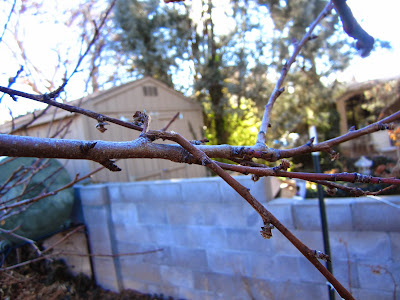Removing Broken Branches
Broken branches are common in fruit trees. This can be caused by heavy fruit loads in the summer or heavy snow loads in the winter. Wind, animals, and clumsy gardeners can also contribute to broken branches. Proper pruning techniques like those found in our free 9 Lesson Fruit Tree Pruning Course, will help prevent branch failure. Consider the following pruning techniques to minimize broken branches.
Choose branches with a strong crotch. This means that the branch is at a 45-90 degree angle from the trunk. Although it may seem counter intuitive, branches that are less acute to the trunk are stronger and can support heavier loads. Follow this link for more information on strong branch angles.
 |
| Weak and Strong Branch Angles |
Have you propped up branches to support them under a heavy fruit load? If your tree is pruned correctly, this practice will not be necessary. When pruning, avoid removing the spurs that are located on good strong branches. Old growth spurs should be your primary fruit producing branches. These spurs will only be successful if they are not shaded out by the rest of the canopy, so thinning your canopy and opening the center of your tree by removing the leader will help light to penetrate the canopy to the older, more productive parts of your tree.
Cut back or remove weak, spindly branches and water sprouts that are unable to support heavy loads. Imagine each branch loaded with fruit when you are pruning your trees, and ask yourself, "Will this branch be strong enough to support clusters of mature fruit?" Also, ask yourself, "Which way will this branch bend under a heavy load?" The purpose of asking these questions is to determine how far back you will need to prune each branch so that it will be able support the weight of fully ripened fruit.
 |
| Broken Branches on a Peach Tree |
Avoid letting the lower branches of your fruit trees extend too far out. If the canopy of your tree is too thick, the lower branches will be forced to grow out farther and farther to capture the light they need to survive, making them weak and unsuitable for supporting heavy loads. When holding heavy objects, you naturally bring them close to your body and your frame will aide in the support of that object. The same goes with fruit trees. Branches closest to the trunk will be able to support heavy loads better that branches the are over extended.
A simple rule to remember when pruning your fruit tree is to train branches that are growing out to grow up and branches that are growing up to grow out. This is done by pruning branches back to a bud that is facing the direction that you would like your tree to grow. It would be wise to keep all of your secondary and scaffold branches at approximately 45 degrees from vertical. The image below shows what a branch looks like that has been pruned this way for years. Notice the way that the branch has a zigzag pattern because it was pruned to alternate up and out, but the overall direction of the branch is about 45 degrees.
Each spring, when you prune your fruit trees, inevitably you will find some branches with damage from the previous year. It is important to remove these branches to make room for healthier ones. Damaged branches leave your tree exposed to possible pest infestations.
 | ||||
| Damaged Branch on an Apricot Tree |
Thanks for reading! To learn more about pruning fruit trees, please take our free 9 Part Fruit Tree Pruning Course and join our Backyard Fruit Growers Facebook Group. Also, Subscribe to our Fruit Pruning Youtube Channel.




Comments
Post a Comment